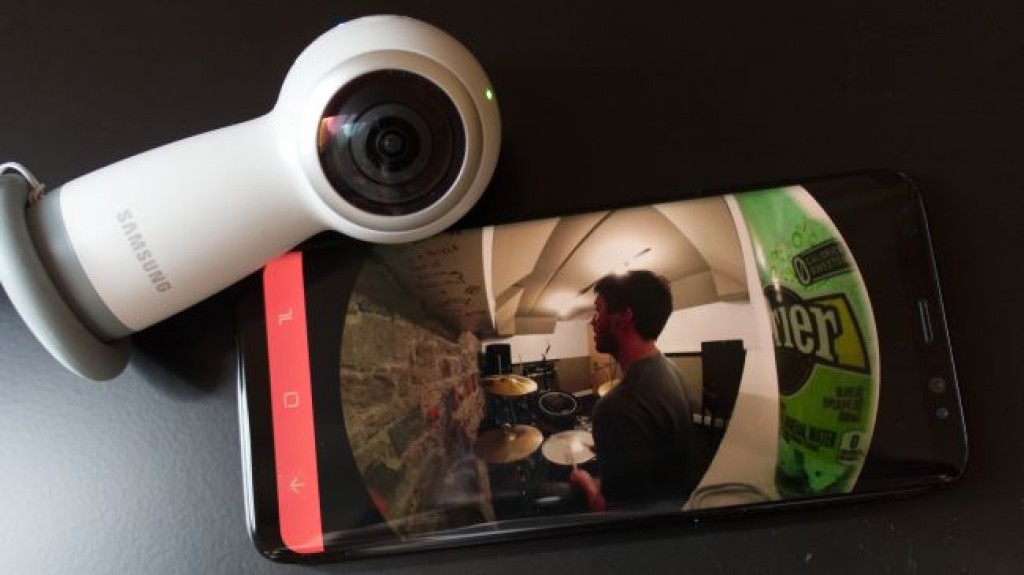
OUR VERDICT
The 2017 edition of Samsung’s Gear 360 is easy and fun to use, especially if you haven’t dipped into 360-degree video before. At $229, it’s definitely one of the best values on the market, too. But be warned, the video quality can be iffy, and opting for iOS compatibility over working with non-Samsung Android phones is a puzzling move.
FOR
- Fun, capable software
- Good price
- Works with iOS
- Slick, ergonomic design
AGAINST
- Disappointing video quality
- Slight downgrade in specs over 2016 model
- Limited Android compatibility
The Samsung Gear 360 is just a video camera. But thanks to its dual-camera setup, it doesn’t just record the world, it records your world with you included in on the fun.
In that sense, the new Samsung Gear 360 for 2017 shares the same goal as the first iteration: make shooting 360-degree video content easy and relatively affordable. However, it goes about its mission in a much sleeker fashion, ditching the bulbous heft of last year’s model and opting for a more portable build that’s arguably easier and more fun to use.
Samsung has also slashed at its price, reducing it down from the $369 cost of the original down to a much more palatable $229 ( £219, AU$399) at launch.
However, not all of the changes are positive ones. For instance, the aperture and megapixel values on each of the two 180-degree lenses are a step back from what we found in last year’s version. Also, the battery capacity has taken a bit of a hit in the journey to slimming down its form factor and is now non-removable.
And although it’s billed as a 4K camera, you’ll want to lower your expectations before you dive right in. The pixel value of the 360-degree footage may give it 4K numbers, but each part of the video looks almost sub-HD at times.
But given its lower price tag, ease of use, the added iOS compatibility and super fun software, Samsung’s new VR-ready camera is an easy sell, but not worth it if this isn’t your first 360-degree camera.

Features
- “4K” 360-degree video capture at 24FPS / 1080p at 60FPS
- Captures 8.4MP still and time-lapse footage at 10FPS
- Use can switch between dual and single camera recording
High-speed sports camera, this is not. But Samsung looks to the Gear 360 to steal away some of GoPro’s pie with a stellar companion mobile app and robust desktop application bundled in.
It’s a surprise to nobody that the main appeal of this camera is that it can shoot video in a full, world-encompassing 360-degrees. The pocket-size construct of Samsung’s Gear 360 for 2017 makes it a more ideal option than last year’s model for those on the go, whether you’re capturing some precious vacation memories or just showing off your neighborhood to the world via Facebook Live.
But why record in 360-degrees, you ask? Well, for a variety of reasons. It’s cool. Your current camera probably can’t do it. Plus (and most importantly) these clips are viewable inside of VR headset, whether it be the Samsung Gear VR, the Google Daydream View, or any other major headset. Someone else can step into your shoes and see what your world looks like. Enough said.

In dual-lens mode, the Gear 360 can record video at a resolution advertised as 4K in 24 frames per second (fps), 2K (QHD) at 30fps and above 1080p in 60fps.
If you’ve never seen this sort of thing in action, it seems pretty magical. Samsung’s recording algorithm stitches together the feed from the two lenses to make it look as seamless as possible. However, we noticed that the more action-packed the footage is, the more that tearing can be seen at the seams.
Additionally, users can record with a single lens, which tops out at 1080p resolution at 60 frames per second. This mode is perfect for when you want to capture some video, but you want to keep your bad hair day out of the picture.
Video isn’t the Gear 360’s only forte. It can also take still photos and time-lapse footage as well. While reduced from 15MP, as we saw in the original Gear 360, to 8.4MP, the photographs that this camera can churn out are quite good, rivaled in quality by the best smartphones around that have awesome cameras.
However, taking quick snaps with the Gear 360 is a hassle by comparison since you can’t easily preview your photos to make sure you got the perfect shot.
The Samsung Gear 360 is cute. Other ways to describe it include that it looks like it belongs in the Pixar logo, and that it is shaped like a friendly cyclops.
Rounded on every corner, Samsung’s efforts to make shooting 360-degree video approachable and ergonomic show in the solid build quality and inviting design implemented here.
Taking a tour around the Gear 360, you’ll find one wide-angle lens on each side and some buttons peppered around the unit.
On the “front” lens, which bears no obvious indication of that designation other than a vague LED light, you’ll find a large button that triggers the recording function.
Underneath, there’s a small screen that shows some pertinent info based on the mode that you’re currently on. If you’re recording video, it will display how much footage can be recorded on the memory card. Taking photos? Then it will show how many can be taken before you run out of space.
You can navigate through the screen’s limited menu by using the two buttons mounted to the side of the camera’s two lenses. One can be held to power the unit on or off and head back while inside the menu. The other triggers the menu with a tap. Additionally, you can enable Bluetooth pairing by holding down this button.
The only other physical features to speak of are its microSD slot, which flanks the small, circular screen, its camera tripod mount and the grippy stand that provides stability for the Gear 360 when it’s sitting on a desk.

Performance
For as much promise as 360-degree video capture holds, the Samsung Gear 360 isn’t the best vessel for recording it with. That’s mostly because for as much as it touts its 4K resolution, the footage really doesn’t look all that great.
That’s probably because it isn’t true 4K as you may know it. Instead of providing the sort of pixel density you’d expect from a TV boasting that resolution, it seems to spread it across the entire 360-degree view, leaving you with footage that almost looks sub-HD at times.
Unfortunately, what is ideal, something like Google’s Jump VR camera rig, costs an exorbitant amount of cash by comparison. So, for the $229 cost, Samsung is asking a palatable price to pay for decent 360-degree video, even if the results aren’t as optimal as it is painting with its marketing language. Where the Gear 360 wins is with its balanced exposure and color accuracy. It was hard to catch the sensors offbeat in this regard.
In terms of battery life, the Gear 360 2017 features an 1,160mAh non-swappable battery. Compare that to the 1,350mAh found in last year’s that was replaceable and the new model gets a strike against it.
What this means for everyday use is that you’ll need to carry around a USB-C compatible portable charger to keep this Gear 360 going all day. Battery life was good in our experience, but it varies wildly depending on how you use the camera.
For instance, recording 1080p footage with a single lens discharges about half as fast as recording with both lenses. If you’re using the Gear 360 to solely snap photos, it can easily last a few days performing this function.

Software
Compatible with iOS 10+ smartphones, as well as Samsung phones no older than the Samsung Galaxy S6
I wasn’t expecting to be spending much time at all fiddling with the Gear 360 companion app. However, after recording some footage and snapping some photos, I found myself unable to pull myself away.
Connecting is easy. On an iOS phone or one of Samsung’s, you’ll just need to make sure you have the Gear 360 app to get started.
Once you’re up and running, not only can you get a live view through the camera from within the application, you can apply all sorts of interesting viewpoints to your content. My favorite is “Round view”, which basically deletes the horizon and wraps the image around in a circle to make it look like you’re walking on a small planet.
Dual view and the others, like panoramic and stretched modes are also neat, as they show what each of the lenses is capturing at every moment.
You may or may not spend nearly as much time in the app as I did, however, you’ll have to use it when it comes time to transfer your content over to a PC, a phone or just uploading it to the cloud instead.
Currently, the app allows you to upload to a cloud storage solution of your choice, from which you can edit it on your PC. You can also transfer it straight to your phone to share on social media or just keep available for use with Gear VR.
I haven’t even mentioned the Action Director software yet. Along with the purchase, you’ll get access to a full-fledged video editor that works for both macOS and Windows users. Compared to the mobile app, this is the one you’ll want to use for creating a polished video, complete with titles, transitions and light visual effects.
In addition to editing your 360-degree videos, you can also livestream straight from your PC to YouTube, Facebook or Samsung VR. Simply put, this free software really sweetens the deal.
I’m certain that the tools that Samsung provides would allow me to create my magnum opus, but for the purposes of this review, I limited my editing to 10 minutes to see what I could get done. In that time, I imported a handful of 360-degree videos and inserted some transitions with ease. Enjoy my admittedly hastily-made video and stay tuned for my debut at Cannes in 2018.
Samsung deserves kudos not just for this powerful software bundled into the price, but for adding iOS support for the camera. The previous iteration only supported select Samsung phones. Now, all that’s left out are the many, many other Android manufacturers.
Verdict
Like it did last year with the original Gear 360, Samsung is treading forward in making 360-degree videos more accessible than ever.
Adding in iOS compatibility for its latest model will certainly help to boost viewership and adoption of the medium and the simplicity of its companion app only furthers its reach.
Unfortunately, the new Gear 360 2017 will only get so far as it falls back on some hardships, namely its at-times uninspired video quality and the non-removable battery. While Samsung gets points for broadening compatibility to Apple’s side of the fence, it has ignored every single other Android OEM, a puzzling move.
If this is your first 360-degree camera, there’s little reason to hesitate with the new Gear 360. Current Gear 360 owners need not apply, but compared to other options on the market, Samsung’s package sticks out just a smidgen further thanks to its awesome software and forward-thinking design.
Sоurсе: techradar.com









































